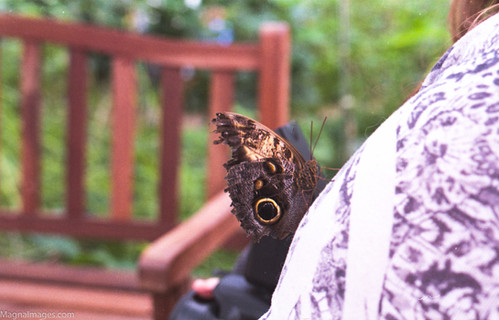
The Olympus IS-10 is a strange beast to be sure, it’s also beautiful in its design. To me the IS-10 looks like a visual triumph in 90s camera design. The camera make its debut in 1994The shape and look of this camera is interesting and beautiful with its sleek curves and lack of sharp edges. It doesn’t feel like an SLR, it feels like it belongs on a Star Trek set. The grip on this camera is very nice, even though the camera is narrower than many SLRs it still manages to feel very comfortable in the hands. The ergonomics of this camera are great. The camera also weighs enough to feel solid, it feels like it’s built like a brick, I like this a lot.

When it comes to snapshots this camera doesn’t do so great. If you forget that this isn’t a good SLR and just let the camera control everything it does ok. If you even begin to want to mess with trying to control anything about how your camera behaves, you will have a nightmare of a time.

The camera only has five shooting modes, none of which are very clear from the little pictures. You have; Starmoon, "MAX" the runner, Female mode,“Man in front of mountain,” and “FULL AUTO” for mowing people down. Okay, actually the shooting modes take some getting used to. “FULL AUTO” mode lets the camera handle everything about the image. The mode to the left with the star and moon icon indicates night shooting, presumable this sacrifices aperture for faster shutter speed. The top mode with the mountain is for shooting people in front of distant objects. The mode to the right with the woman is the “portrait” mode and gives you the option of some bokeh. Lastly the bottom mode is your sport mode and sacrifices aperture for shutter speed in an attempt to catch action. You have two metering modes selected by a button.

Strangely with so little control you do have a button labeled “F.No.” which controls your F-stop until you change shooting modes. I don’t understand this decision at all since you can’t manually control anything else about your camera. It’s also strange that you would have such an option at all given that you can’t control your shutter speed. On the plus side though your shutter release button does have two steps, so focusing this camera is intuitive if you’ve ever used an SLR before. I tried a lot to create shots with bokeh but failed to get satisfactory focus with this camera. I’d hold the shutter release button down halfway on my subject, then pull the camera away to frame my image only to have the camera refocus. In a lot of cameras you can get around this by framing after focusing and then slamming the shutter release down before the camera can try to focus. This camera insisted on having “focus” before shooting no matter how hard I tried. Yes, I realize that there is a “focus lock” feature. The problem is that it doesn’t work half the time. Also if you use it your metering is also locked.

The camera does boast a 28-110 Zoom lens. This is a great lens setup for the camera. Unfortunately the optical train is bad. I love the gentle curves that protect the lens and integrate it into the body. Some bridge cameras try to pretend to be fancy SLRs yet this camera chose to make the lens sleekly integrated into the body. The With such a nice looking shutter and a fairly decent lens I feel pretty bad about not being able to unlock their potential thanks to such a wonky control scheme. To add insult to injury some reviewers actually said that this camera was too complicated. I want to disagree but I think they were right. This camera has more buttons than the Canon Rebel XS we reviewed previously. With so many buttons one would expect to have more control, perhaps too much. But instead we are left with barely any control.

The viewfinder is tiny and I had a hard time seeing the entire frame in it. On the plus size the viewfinder does have a diopter adjustment control and that really allowed me to dial in a sharp view where I could see. The camera also comes with some nice strap studs that are moulded right into the plastic body.
The camera takes two CR123A or DL123A batteries so it should be simple to get this camera some batteries if you find one. This camera also has a DX film reader which was nice when we used it with 3 different ISOs of film. The bad news is that you won’t be using non DX film with this camera as there is no way to manually set, it goes by default to 32 ISO. All of our black and white film roll we shot in this camera was useless. You can “hack” this problem in the camera by shorting the DX pins, but it’s sad not to be able to shoot non DX film. DX is going away in the new film market and this may become a problem in the future.
You may be wondering about the button on the back of the camera that says, “IR/Remote.” That button enables a self-timer, but also enables the use of a remote to trigger the camera. The remote is RC-100 if you ever want to search Ebay for one.
When it came to actually shooting the camera the pictures were hit and miss. I could get decent pictures with a monopod and subjects that were a fair distance away. However the camera has several problems when you take pictures. First off is the very slow autofocus. The camera spends a lot of time "hunting" for focus. Many times I found that the camera thought that it had focus yet was totally off, so I'd have to try to focus again.

Exposures were also hit and miss. Sometimes you can get a camera to take decent exposures by saying, "Fine, use your flash, just compensate and give me a good-metered exposure.

Woe to you who wants to do any sort of marco photography with this camera. Small subjects really showcase how mediocre the lens on this camera is. Combined with no manual focus this camera simply isn't up to the task. Telephoto is just as bad due to the slow focusing getting slower when zoomed in.

Indoors with 800 ISO film the camera couldn't figure out what it wanted to do. It seemed like the camera hated everything I wanted to take a picture of at some points. I was frustrated by how one minute I'd hear a long "clunk" of a very long exposure, then the next one would be a fast snap.

Inability to see how the camera is metering means blown highlights or underexposed images. You have to put all your faith in this camera, and it will shake that faith every time you go to look at your negatives.


Once in a while though you would get a nice photo like this. The image is a tiny bit soft. When you look at the distance from me to the subject along with the bright afternoon light you realize the problem I am describing. Only under perfect conditions will this camera do what it should. I'm not being mean to this camera, but when it claims to be an SLR I have no choice but to compare it to the many good SLRs out there.
As someone who has a lot of experience with SLR/DSLR cameras I was disappointed over and over by this camera. However the problem isn’t the whole camera, it’s the fact that the camera looks and feels like it should be so much more than it is and also feels like a prototype. The camera lacks necessary features to be good. If you try to use this camera for any sort of serious photography you will find yourself very disappointed very quickly. At the same time the fact that the camera does bad things when you try to achieve focus also makes this camera not a good choice for snapshots or inexperienced users. Overall I’d give this camera a pass unless you like the way it looks and want it for your shelf.
Sample pictures can be seen below. We tested this camera with several rolls of film with different ISOs from 200-800. We gave this camera a chance and it failed.








































